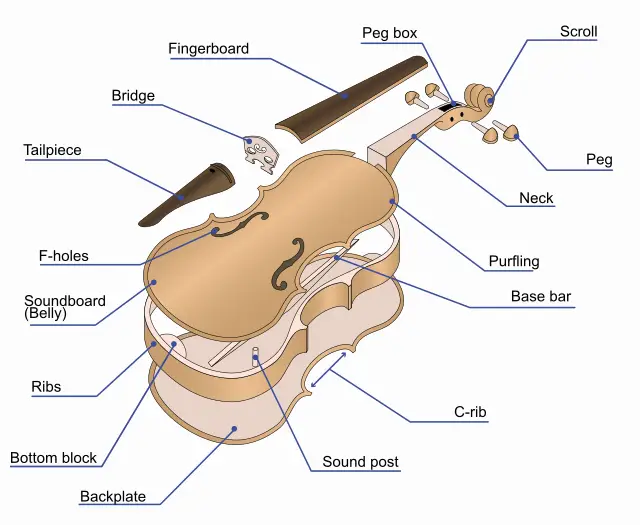Water can cause significant damage to the structural integrity of the violin. When wood gets wet it changes shape and distorts, causing sound quality to decrease. But this depends on how wet a violin gets and for how long.
In this article we look at how badly water can damage the violin and the immediate steps to follow to reduce water damage to your violin.
Here’s How Badly Water Can Damage a Violin:
Water can cause significant damage to a violin. Wood is particularly susceptible to water damage and can warp, causing changes to the sound quality. It’s important to limit exposure to rain and to never use water as a cleaning product. If a violin does get wet, loosen the strings immediately and slowly dry it out.
Table of Contents
What Specific Damage Can Water Cause to a Violin?
Depending on how wet a violin gets, water can cause irreversible damage to a violin. In order to understand what moisture or excessive humidity does to a violin, let’s first examine what a violin is made of:
- The body, neck, tailpiece, bridge, soundpost, and pegs are made of different types of bent and treated wood, glued with hide glue, then covered with an oil-based varnish.
- The strings are made of nylon, steel, or organic material (called catgut or sheep intestines)
- The bow is made of wood and horsehair.
Water affects these materials differently, causing each of them to change characteristics:
- Wood that gets damp or wet absorbs water and expands, changing its shape. And once it dries out, it gets bent and distorted, depending on the tension applied to it as it’s drying.
- The varnish is eaten away gradually, peeling off in spots and thinning out if the violin remains wet for a long time.
- The hide glue (made of animal hooves) is water-soluble, so if the instrument sits in water for too long, the seams come apart.
- The strings mostly remain intact, but depending on the traumatic forces applied to the violin, they can break.
These changes cause the instrument to change shape and sound. If the violin got soaked, you’d find the pegs stuck in their holes, the fingerboard sunken, and the seams breaking open, especially at the bottom of the instrument.
The sound will be thicker and “fatter” without much resonance. If you tap on the violin’s body, it won’t ring out, sounding more like a dull thud instead.

How to Limit The Damage Water Causes to a Violin
Fortunately there are specific steps you can take to limit water damage to your violin. We’ve divided this into immediate action and how to dry out a damp violin.
What actions to take immediately:
- If the violin was inside of its case when it got rained on, take it out of the case immediately.
- Loosen the strings completely using the pegs. If the pegs are too swollen and stuck, cut the strings. This will prevent the neck from snapping under the tension they’re applying.
- Empty out any water inside the body until there’s nothing else inside.
How to Effectively Dry Out a Wet Violin:
This part will depend on how long the water sat on top of or inside the violin.
If the violin was barely damp:
- Wipe the surface of the violin thoroughly using a dry, soft cloth. An old cotton t-shirt or microfiber towel will work great here.
- Leave it out of its case at ambient room temperature, surrounded by paper bags or kitchen towels.
- Don’t try to expedite the drying process using a hairdryer as it will cause warpage and cracking in the wood.
If the violin is soaked or waterlogged
- Wipe off any visible mold, if present.
- Leave the instrument to air dry completely.
- If you have a dehumidifier, you can put it in a spare room with the violin and set it to be about 5% less humid than ambient humidity. After a day or so, reduce the humidity by an extra 5%. You can stop when the ambient humidity in the room is about 50%.
- If the seams have come apart, this will make the wood dry faster. Just make sure it’s not in an unusual position that can cause it to warp.
- Take the violin to a professional luthier who can assess the damage and fix it.
Note: wet wooden violins aren’t like electronics, so you can’t fill the cavity with rice to absorb excess moisture. In fact, rice grains will probably develop a starchy, wet exterior that will stick to the unfinished wood inside the body.
Are Violins At All Waterproof?
The glossy, varnished exterior of a wooden violin might lead you to believe it’s waterproof, but the body of the violin is unfinished on the inside.
This means that a couple of waterdrops on the violin’s exterior can be wiped off. However, if water gets inside the cavity, it soaks into the wood and starts changing its structure.
Always keep your violin in a waterproof case if you intend to go out in wet conditions with your instrument.
Should You Ever Clean a Violin With Water?
Never clean a violin with water, even if it’s a small spot and you intend to wipe it off immediately. Water can get into the wood via small unvarnished cracks, thinned varnish, or glued seams.
Once this happens, the glossy top layer will fade or crack. There’s also the possibility of mold or mildew growing inside the violin if water reaches the cavity.
To keep your violin clean, just use a dry, soft cotton cloth to wipe it clean after every playing session. This will maintain the shiny, seamless appearance and remove any rosin bits or sweat that gets on the body.
If it’s in worse shape than usual, you can use a designated wooden instrument cleaner. They usually have solvents that won’t affect the finish of the violin.
Can You Clean Violin Strings With Water?
Sometimes violinists over-do the application of rosin, causing the bow to get bogged down in the strings. In this situation it may be tempting to use water to clean the strings but this would worsen the situation.
You can’t effectively remove rosin from strings using water since it’s not water-soluble. The best way to get it out is to firmly wipe the strings with a clean, soft cloth or microfiber towel after every use.
If it’s too far caked, you can use the side of an old credit card to gently scrape the strings. This will get most of the rosin out before you wipe it with a clean cloth.
What About Playing Violins in the Rain?
Carbon fiber violins can be played in the rain wonderfully. However we’d recommend never playing a wooden violin in the rain, even for a short period of time. The damage that can be caused is too significant to justify the enjoyment.
The body of the violin can fill up with water, preventing it from sounding like a violin. The potential long term damage can also be substantial. Avoid playing in wet, humid conditions where possible.
What Action to Take if Your Violin Bow Gets Wet?
Fortunately a wet violin bow is not as severe as a wet violin. Unlike the body of a violin, a hardwood or carbon fiber bow stick is mostly waterproof. So, you can just dry the stick with a clean, soft cloth.
Next, loosen the frog completely, so there’s no tension on the wet bow hair.
Bow hair is usually made of horse hair, which is very similar in structure to human hair. And as you might have heard, hair is at its weakest when it’s soaking wet.
If rosin has gunked up the hairs, just wash them with mild dish soap or scentless shampoo and water. Hang them to air dry, don’t use a hairdryer, and then reattach them to the stick.
Conclusion
The severity of water damage to the violin depends how much water got to it and how long it was allowed to sit there.
Wooden instruments aren’t waterproof due to the unfinished interior cavity. If water gets into it, the wood starts absorbing water like a sponge, changing its structure.
Try to stay out of situations where your violin might get wet. If it does, dry it gradually or ask a professional luthier for help.
